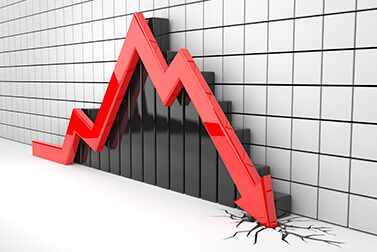
According to the ruling narrative, the current bull market for global equities started in March 2009, is thus almost eleven years old and it looks like it might come to an end in similar fashion as the previous bull market that started in 2003 and finished with a spectacular fall of -50% (or more) between late 2007 and early March 2009.
That narrative, however, though popular and dominant, is based upon an extremely narrow and subjective assessment of what has occurred in global financial markets over the period.
On my analysis, which I think is more accurate and useful for investors, the current Bear Market is the fourth since the really big one in 2007-2009. The first conclusion therefore should not be that something extraordinary is happening in markets today.
Central bankers might be inclined to think they have managed the post-GFC period rather splendidly, but in reality economies and financial markets have become more vulnerable to regularly re-occurring shocks.
Back in 2011 Europe was on the brink of implosion, while four years later global trade kept sliding downwards, feeding market concerns China might be facing its day of reckoning. By late 2018 an over-confident Federal Reserve was seriously underestimating the impact of its policy reversal on the US economy.
In all three cases, eventually a solution was found and the downtrend in global risk appetite reversed, allowing equities to continue their uptrend towards new all-time highs. This principle applies to every Bear Market, big and small, investors have witnessed throughout their lifetime.
In the short term, fear and confusion feed into uncertainty, which usually triggers selling, which triggers more fear and uncertainty, and thus more selling. It’s not easy to separate oneself from the psychological impact that a panicked run-for-the-hills, sell-everything reflex has, like the one we are experiencing on Monday.
The question on every investor’s mind is: how long before we can resume business as usual? But that’s not an easy question to answer. It entirely depends on how long the news flow will remain negative, whether central banks and governments can calm animal spirits and offer a reasonable way out of the present downtrend, but also whether the current economic slowdown might expose more weaknesses.
In the latter regard it is worth reminding investors the high yield corporate bond market in the US comprises of lower quality balance sheets in the mid-cap and small cap oil and gas sector. Now that OPEC and Russia have abandoned their joint production limit agreement, causing crude oil prices to collapse, with further downside seen by sector analysts, scenarios of mass-defaults on US corporate junk bonds are once again a real and tangible threat.
It is for this same reason the energy sector was the worst performing in early 2016 and it is back into that same position this time around. Santos ((STO)), in the Australian context, is not an iddly piddly micro-cap explorer/producer but on Monday its share price is trading down in excess of -25% on the day, taking total losses since mid-January close to -45%.
To add to the sector’s misery, Oil Search ((OSH) shares lost -35% off their value. Karoon Energy ((KAR)) lost close to -47%. On. The. Day.
While commentators elsewhere are pointing out cheaper oil prices are beneficial to consumers of fossil fuel, and thus possibly part of the ultimate solution/recovery, the danger is that troubles inside the high yielding corporate debt market in the US flow on to much bigger problems for lenders and (lower quality) corporate credit in general, just like sub-prime mortgages and related derivatives did back in 2008.
In other words: while markets will remain eagle-eyed on statistics and further developments regarding covid-19 in China and elsewhere, this year’s problems have already well-exceeded the question whether and when the world will be able to contain this new virus spreading.
The core question now is whether investors should prepare for a recession, whether such a recession might be short and mild, and whether this economic slowdown triggers deeper problems inside the global financial system.
One wise and experienced market commentator once pointed out that in the moment of extreme duress, our minds tend to focus on worst case scenarios, while such scenarios have a habit of not materialising.
That may well be true, and certainly the experiences with Bear Markets in 2011, 2015 and 2018 underlines such observation, it is also true that sometimes a bad situation can become a lot worse before a recovery announces itself.
That certainly was the case in 2007 when initial problems started accumulating throughout the year, but financial markets only started selling off in a violent manner from January 2008 onwards, and the continuous slide downwards would not stop until after the first week of March 2009.
(Admittedly, there also was a brief flash-crash in mid-2007).
Lessons To Remember
So are there any lessons investors can draw from the three previous Bear Markets?
Lesson number one appears to be that impatience now is every investor’s worst enemy. The Bear Market that started in 2011 continued to pull share markets lower for seven consecutive months without respite. The chart below shows three downward pointing arrows for each Bear Market period, including the present downturn which represents the fourth on the far right.
The bars shown are monthly share indices performances which is a wonderful way to show the bigger trend without getting lost in day-to-day volatility. Of course, share prices went up as well as down throughout those seven months, but at the end of each successive month they traded at a lower level than at the beginning of each month.
Such is the nature of Bear Markets. By the time they end, impatient investors have long thrown in the towel.
Not quite sure whether the second Bear Market of 2015-early 2016 has a more optimistic story to tell. Judging from the chart below, it can be argued this particular Bear Market lasted for twelve months, during which only three months managed to generate a positive performance (bars in blue).
In 2018, the final four months of the calendar year pushed equity prices lower and lower, until the Federal Reserve got the message.
Equally important to remember is that every Bear Market has times of indiscriminate selling; days when nothing seems to be worth anything, and everything that is listed goes out with the bathwater. But Quality and defensive qualifications will rise to the surface. That even happened during the Bear Market of 2008-2009.
For investors it is not only important to decide how much of their portfolios goes into cash to weather out the short-term turmoil and continued uncertainty, it is equally of paramount importance portfolios are re-positioned for the new reality that earnings forecasts need to re-set lower, potentially a lot lower.
The key message here is that not every listed stock is equal – see Santos et al earlier. The cardinal mistake many investors make is believing that low quality, weak and vulnerable companies are good places to hide because their share prices are already much cheaper valued than popular Quality outperformers such as Woolworths (ASX:WOW), CSL (ASX:CSL) and ResMed (ASX:RMD).
It usually doesn’t take long before this myth is burned and buried. Take Myer (ASX:MYR) for example. Its share price weakened from 65c to 35c between the release of FY19 financials in September last year and last week’s interim report. After that interim report the share price has fallen to 27c, widening the losses for loyal shareholders since September from -46% to -58.5%.
This might be as opportune as any other time to remind investors of that old share market joke: what’s a stock that has fallen by -90%?
That’s a stock that first fell by -80%, and then halved in price.
Risks To Watch
Bear Markets show no mercy with any form of weakness or vulnerabilities, as such:
- Small cap companies are more exposed to funds outflows than larger cap peers
- Cyclicals and other companies leveraged to economic growth are more vulnerable than utilities, infrastructure owners and healthcare services providers
- Absolute no-nos include weak balance sheets (too much debt) and unprofitable business models, in particular if there is a chance a company might need to raise additional capital
Post the recent February reporting season there is extra incentive for continued selling of stocks in companies that heavily disappointed. See Myer. See AMA Group (ASX:AMA). See Amaysim Australia (ASX:AYS). See Citadel Group (ASX:CGL), and many others.
Investors have been quick in selling out of airlines, hotels, airports, travel agents and tourism operators on the back of consumers changing attitude and spending as the spreading virus triggers panic, but investors would be wise to also focus on which companies will be disadvantaged by further interest rate cuts as central bankers are likely to continue pushing on a string in order to prevent worst case scenarios.
The first sector that comes to mind are Australian banks. Not only is the RBA likely to deliver at least one more rate cut, it is but logical to expect bad debts will start rising. Other companies disadvantaged by lower interest rates and bond yields include platform operators such as Netwealth Group (ASX:NWL) and Hub24 (ASX:HUB), as well as Computershare (ASX:CPU).
The one good thing that might come out of the current crisis (because that’s what we are in) is that governments around the world will finally have to step in and abandon their policy of leaving everything to central banks.
Whether such interventions will prove timely and efficient, only time will tell, but judging from Monday’s price action, markets are making it abundantly clear no government can continue to sit on the sidelines with empty promises and no real fiscal action or targeted stimulus.
Reading all of the above, many an investor must be wondering why bother? Might as well sell everything and see what happens next from the sideline.
The reality is such a move always looks like the correct one when markets push lower in an indiscriminate and significant manner, but volatility works both ways. Markets might not necessarily remain in lock-step with negative news flow.
Anecdotal evidence suggests many investors who sold out of equities in late 2018 only returned by late last year, and unless they sold out quickly in February, these investors missed out on dividends and the big rally last year, plus they are now underwater on their return into the market.
Harry Hindsight will tell us, it was prescient to sell everything at the start of each of the past Bear Markets, and only return once the trend started moving upwards. In practice, this is much more difficult to execute. History suggests the world will find a way out of the current bad news flow, but at the same time, things can get a lot worse first.
Hence my suggestion for investors is to find a balance between the two opposing scenarios. Raise cash up to a level that makes you comfortable. Stick with High Quality and Low Vulnerability in the share market. Reduce risk. Abandon bad decisions that won’t come good anytime soon. And watch further developments closely. You can add gold or government bonds if you want extra short-term protection, but best to stay clear from high yield US corporate debt.
Contrary to what many (bearish) traders and commentators will have you believe, there is no certain outcome from what is happening in financial markets. This is a process that needs to run its course.
At the same time, let’s not be naive about what is happening. Back in 2007, the real problem was hiding in ninja home loans (no income, no job & no assets) and fraudulent sales practices by virtually all American lenders and investment banks.
We don’t know yet what might come out of the woodwork this time around. Then again, nothing such sinister appeared from left field in either 2011-12 or 2015-16 or the final four months of 2018.
Always difficult to predict when or what weakness in the system will reveal itself, or if it does at all. Whatever you do, don’t panic. Make sure you are comfortable (as good as can be).
FNArena subscribers interested in my research into All-Weather Performers might be pleased to know most of the High Quality performers identified on the dedicated section of the website have held up much better than your average share market exposure these past few extremely volatile weeks.
While I will continue monitoring and updating my selections, to date any changes made have been few and far between.
Looking Through The Valley Of Pain
Market strategists at Wilsons suggest the best strategy for investors is to focus on two types of stocks in the share market:
- Great Businesses One Should Own
- Companies that are likely to recover relatively quickly from initial covid-19 impact
FNArena provides independent analysis and proprietary tools for self-researching investors. Our service can be trialled for free at www.fnarena.com
Strawman is Australia’s premier online investment club. Join for free to access independent & actionable recommendations from proven private investors.
Disclaimer– The author may hold positions in the stocks mentioned in this publication, at the time of writing. The information contained in the publication and the links shared are general in nature and does not take into account your personal situation. You should consider whether the information is appropriate to your needs, and where appropriate, seek professional advice from a financial adviser. For errors that warrant correction please contact the editor at [email protected].
© 2020 Strawman Pty Ltd. All rights reserved.
| Privacy Policy | Terms of Service | Financial Services Guide |
ACN: 610 908 211







